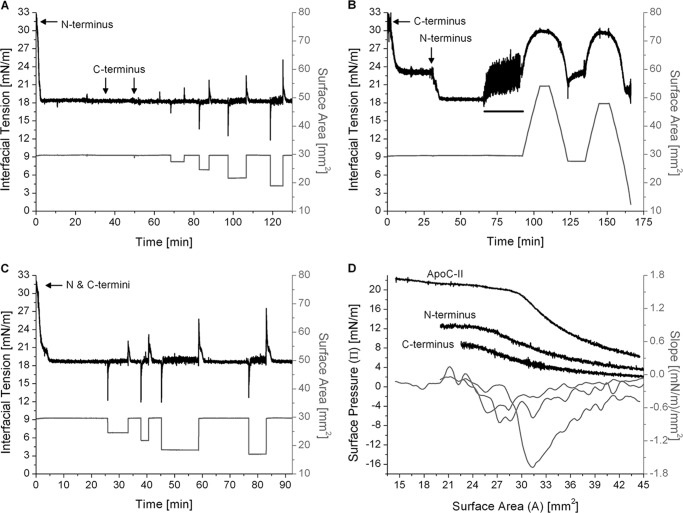FIGURE 7.
The N-terminal domain of apoC-II mediates adsorption and desorption at the TO/W interface. A, the C terminus of apoC-II is unable to displace the N terminus. The N-terminal peptide was added to the aqueous phase at 2.85 μg/ml. Adsorption to a TO drop (V = 16 μl) lowered γ to γeq = 18.3 mN/m. The C-terminal peptide was added to the aqueous phase at 25.8 and 49.8 min (marked by arrows) to final concentrations of 2.85 and 5.70 μg/ml. There were no significant changes in γ. Drop volume was rapidly compressed and re-expanded in increments of ±2.1, ±4.0, ±6.0, and ±8.0 μl. In each case, re-adsorption decreased γ to γeq = 18.2 ± 0.1 mN/m. B, the N terminus of apoC-II displaces the C terminus. The C-terminal peptide was added to the aqueous phase at 2.85 μg/ml. Adsorption to the TO/W interface lowered γ to γeq = 23.1 mN/m. The N-terminal peptide was added to the aqueous phase at 31.1 min (marked by an arrow) to a concentration of 2.85 μg/ml. γ decreased to γeq = 18.5 mN/m. All peptide was removed from the bulk phase by a washout (black bar, 6.26 ml/min for 25 min starting at 65.5 min). Drop volume underwent two sets of gradual expansions and compressions at a rate of 1.2 μl/min. C, the N terminus adsorbs faster than the C terminus. The N- and C-terminal peptides were added in equal weight ratios to the aqueous phase at 4.6 μg/ml. Adsorption to the TO/W interface lowered γ to γeq = 18.6 mN/m. The drop volume was rapidly compressed and re-expanded in increments of ±3.8, ±5.7, ±8.0, and ±8.7 μl. In each case, re-adsorption decreased γ to γeq = 18.6 mN/m. D, the N terminus desorbs at higher pressures than the C terminus. From experiments similar to those in B, Π/A compression isotherms were generated for the N and C termini at the TO/W interface. These were plotted with an isotherm for full-length apoC-II. A spline fit of smoothing parameter 0.38 was applied to the isotherms. The first derivative of the fits gave slope values (dΠ/dA), which were plotted against area.

